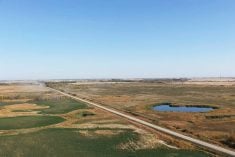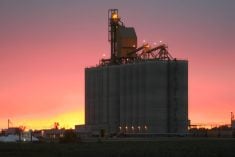With average yields of 33 to 35 bushels per acre, 2024 was a difficult year for canola in Saskatchewan.
Since disappointment is a lingering feeling for many canola growers, there could be an opportunity for alternative crops to grab some acres in 2025.
That said, soybeans aren’t part of the “What can I grow besides canola?” conversation this winter.
Read Also

Cancer agency reclassifies another herbicide ‘probably carcinogenic’
The WHO’s cancer research agency has now put atrazine, a herbicide well known to corn growers, in the same potential-hazard category where the agency put glyphosate.
“I have not heard a single person say anything about soybeans, except the guys who try them … by Redvers, right on the border (with Manitoba),” says Lauren Wensley, the Saskatchewan marketing rep for seed distributor SeCan.
“I still think they (producers) are off the soybeans for the moment… I don’t think it’s soybeans in Saskatchewan yet.”
It’s been a rough stretch of years for soybeans in Saskatchewan. Planted acres dropped from 850,000 in 2017 to about 68,000 in 2023 and 2024.
A lack of mid-summer rain and weak yields, of 25 bushels or less, explains why growers have turned their backs on the beans.
It doesn’t make sense for Saskatchewan farmers to try soybeans unless there’s a shift toward a wet cycle in the weather pattern, Wensley says.
Last summer is a good example. Conditions were too hot and dry for canola, so soybeans would have also suffered.
“Imagine what that would have done to soybeans. (They) want even more moisture,” Wensley says.
“Soybeans would have been a bigger train wreck … I think.”
It’s hard to know if soybeans fared better than canola in Saskatchewan, because acres are limited. However, anecdotal reports from Manitoba suggest soybeans outperformed canola in 2024.
“Yields have been very good this year, ranging from 34 to 65 bu. per acre. Provincial average is expected to be around 40 bu. per acre,” Manitoba Agriculture said in its final crop report of 2024.
Despite the decline in acres and skepticism about soybeans in Saskatchewan, breeders continue to seek varieties that could be a good fit for the province.
They’re focusing on soybeans that are suited for the Black soil zone, where the land can hold more moisture.
“It’s a relatively small (breeding) program, but we’re making some progress,” says Tom Warkentin, a field pea and soybean breeder at the University of Saskatchewan.
Warkentin has developed a variety called CDC Cedar, which performed “decently” last year in trials conducted in western Manitoba.
A big challenge for Warkentin is that he’s trying to create lines that are adapted to the “frontier” of soybean production in North America. Soybeans prefer a warm and wet climate, and much of Saskatchewan is cool and relatively dry.
Sufficient moisture, especially in mid-summer, is critical for soybean production. So, Warkentin and other breeders have been running trials on soybean lines on dryland and irrigated land, in adjacent or nearby fields.
“We may get some clues there. Are there certain lines that are doing reasonably well under dryland,” he says.
Warkentin’s breeding work on soybeans may not pay off for a while, but if it’s possible to get the genetics right, and if the weather shifts to a wet cycle, soybeans could find a place on some farms.
“We need more nitrogen-fixing crops in the system,” Warkentin says.
“Can we find some options for growers in Melfort, Yorkton or Estevan that could be part of their rotation?”
















